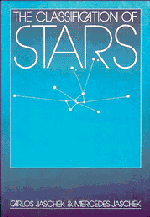Book contents
Preface
Published online by Cambridge University Press: 04 April 2011
Summary
The purpose of this book is to provide an outline of the methods and the results of classification. Classification is one of the fundamental branches of astronomy, in the same way as astrometry is. Classification is used whenever we need to order a large number of objects, or a variety of phenomena. Classification methods appeared in astronomy in the nineteenth century when a large number of stellar spectra suddenly became available, through two technical developments – the objective prism and the photographic plate.
Because the number of spectra was so large, it was impractical to study each of them in detail and later to generalize the similarities found between them. In fact, classification takes just the opposite approach: first groups of similar members are formed from the N individuals, and then typical members of each group are studied in detail. Since the members of a group are similar, the conclusions of the detailed study of typical objects can then be applied to all group members. By replacing a large number of individual stars by a much smaller number of groups and typical objects, a significant economy of work is achieved.
Classification methods use observational data, like objective prism spectra, with minimal interpretation. This stems from the fact that large amounts of data are used, let us say several thousand spectra; if the data were interpreted in a elaborate way, one would be performing analysis and not classification.
- Type
- Chapter
- Information
- The Classification of Stars , pp. ix - xiiiPublisher: Cambridge University PressPrint publication year: 1987

